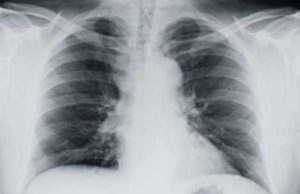
Mesothelioma Diagnosis: Biopsy
Mesothelioma cancer is an infrequent disease that develops from mutating cells in the mesothelium—protective lining of the lungs and other organs.
Malignant mesothelioma cancer is often caused by prolonged exposure to asbestos. Asbestos is a naturally occurring element that was commonly used in various industrial nations for its heat-resistant properties. Although harmless when left alone, the element presents numerous health problems when disrupted. When contacted, asbestos filaments become airborne, thus being susceptible to inhalation. Over time, perpetual inhalation breeds cancerous growths; asbestos fibers stick to the lining of the lungs, where malignant tumors eventually grow. These tumors, over the course of one to two decades will proliferate throughout the body.
Mesothelioma cancer comes in a variety of forms; however, the condition often develops in the lining of the lungs or the internal wall of the abdomen. Common symptoms of malignant mesothelioma cancer include: shortness of breath, which arises from an agglomeration of fluids between the lungs and abdomen, as well as weight loss and persistent coughing.
One of the chief characteristics—and the major reason why mesothelioma prognoses are so pessimistic—stems from its relatively innocuous symptoms. A lack of noticeable symptoms and an inability to detect the disease with medical imaging equipment during its early stages makes mesothelioma extremely hard to diagnose.
Similar to other cancers, malignant mesothelioma is categorized by stage. As the disease progresses, it becomes more deadly. The insidious nature of malignant mesothelioma is paired with its inconspicuousness to create a deadly disease. Mesothelioma sufferers often pass away within 6 months to 1 year of diagnosis.
Frequently, mesothelioma cancers will not be diagnosed until the tumors spread to vital organs. When the disease reaches stage III or stage IV it is ruled inoperable. If, by chance, mesothelioma is detected before proliferation, curable treatments may be administered to extract the malignant tumors. Several palliative treatment methods may also be administered to mitigate the symptoms associated with mesothelioma cancer.
If you or a loved one has worked with asbestos materials in the past you should contact your doctor to schedule a physical examination. This appointment should be made regardless of you feel. Upon evaluation, your doctor will conduct several diagnostic tests to inspect your pleura, lungs and cells. If the doctor notices any abnormalities or irregularities, further tests will be administered to affirm a possible diagnosis. One of the final diagnostic tests will be a biopsy; this mesothelioma diagnostic test will be applied after the doctor has gathered CT Scans, MRI’s and PET scans of your chest and lungs.
Mesothelioma Diagnosis: Biopsy
To reach a conclusive mesothelioma diagnosis, a medical professional must confirm that the patient’s cells are actually cancerous. One of the most effective ways to secure confirmation and ensure an accurate diagnosis is to perform a biopsy. These tests are considered vital to definitively secure a mesothelioma cancer diagnosis.
In simple terms, biopsies refer to the removal of tissues or fluid samples and a subsequent analysis of what was extracted. The extracted sample, when observed under a microscope, may reveal the presence of mesothelioma cancer tumors. The culture may also review, through analysis of the activity and interaction of cells, the amount and type of cancer present in the body.
There are several biopsy procedures for medical professionals to determine the presence of mesothelioma cancers. Different biopsies will be used to evaluate the presence of different mesothelioma cancers. For example, for prospective peritoneal mesothelioma patients, a fine-needle aspiration biopsy will be undertaken, while prospective pleural mesothelioma patients will typically undergo a thoracoscopic biopsy.
A thoracoscopy is very accurate in determining the presence of mesothelioma cancer. This type of biopsy allows for the inspection of the pleural space by extracting tissue samples from the area.
Types of Biopsies for Securing a Mesothelioma Diagnosis:
Although thorcoscopies yield the best results for securing a mesothelioma diagnosis, the procedure is not always appropriate due to fluctuations in tumor locations and other complications. Additional biopsies that may be used to diagnose mesothelioma cancer include the following:
Fine Needle Aspiration Biopsy: This type of biopsy for mesothelioma diagnosis is safe and relatively quick. A fine needle aspiration biopsy uses a long hollow needle to extract up to 10,000 sample cells for examination. The procedure is preferred because it is effective in reaching remote areas of the lungs and chest cavity without the need for anesthesia. A fine needle aspiration biopsy inspects for peritoneal or pleural effusion and is effective with diagnosing mesothelioma cancer at a rate of 84 percent.
Thoracotomy: This type of biopsy is surgical in nature and is used to inspect the lungs, heart, aorta, trachea and diaphragm. For prospective mesothelioma patients a wedge resection (type of thoracotomy) will be performed. This particular thoracotomy is preferred because it leaves the majority of the infected lung space intact. To perform this particular surgery, an instrument is used to extract a wedge-shaped piece of the lung.
Endoscopic Biopsy: This type of biopsy for mesothelioma diagnoses is arguably the most common diagnostic test regarding the cancer. An endoscopic biopsy involves a fiber optic endoscope that shows the surgeon the sampled area. Forceps are attached to the endoscope to remove slivers of tissue from the tumor.
Thoracentesis: This type of biopsy for mesothelioma diagnosis extracts fluids from the pleura and lungs through the use of a hollow needle. The fluids are then analyzed to determine the presence of mesothelioma cancer.
Excisional Biopsies: An excisional biopsy involves the removal of an entire organ or tumor. This procedure eliminates the need for a subsequent surgery to remove the tumor if examinations reveal malignancy.
Core Biopsies: During a core biopsy, only a small percentage of irregular tissue is extracted. A core biopsy is common when the tissue is easy to reach and collect. Unfortunately, the majority of mesothelioma tumors are not located in accessible areas of the body.





























